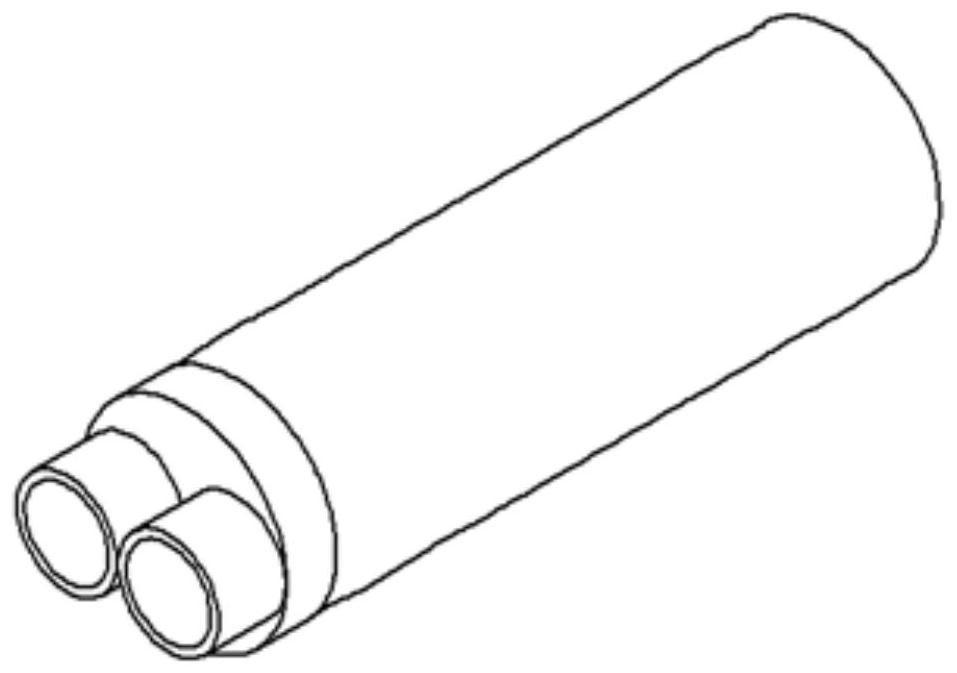Bacterial cellulose composite fiber and preparation method thereof
A technology of bacterial cellulose and bacterial cellulose film, which is applied in the field of bacterial cellulose composite fiber and its preparation, can solve the problems of poor mechanical properties of macroscopic fibers, expensive solvents, complicated processes, etc., achieve excellent mechanical properties, improve mechanical properties, The effect of low system cost
- Summary
- Abstract
- Description
- Claims
- Application Information
AI Technical Summary
Problems solved by technology
Method used
Image
Examples
Embodiment 1
[0030] Step 1. Soak 10 g of bacterial cellulose membrane in 100 mL of NaOH solution for 8 hours. The concentration of NaOH is 10 g / L. After soaking, wash with deionized water until neutral;
[0031] Step 2: Cut the pretreated bacterial cellulose membrane into square pieces with a side length of about 5 cm, add the shredded bacterial cellulose membrane into a mechanical crushing equipment household soymilk machine, and continuously cut for 30 minutes to obtain Bacterial cellulose slurry, freeze-dried;
[0032] Step 3, adding the dried bacterial cellulose to a mixed solution of 50% sulfuric acid and 5wt.% calcium chloride (45g / L) by mass fraction, and passing through a special spinneret with graphene solution (10g / L) Extruded into an ethanol coagulation bath to obtain a composite primary fiber of bacterial cellulose.
[0033] Step 4: The as-spun fiber is stretched twice in a water bath at 60 degrees Celsius to obtain a high-performance bacterial cellulose composite fiber.
Embodiment 2
[0035] Step 1. Soak 10 g of bacterial cellulose membrane in 200 mL of NaOH solution for 8 hours. The concentration of NaOH is 5 g / L. After soaking, wash with deionized water until neutral;
[0036] Step 2: Cut the pretreated bacterial cellulose membrane into square pieces with a side length of about 5 cm, and process the shredded bacterial cellulose membrane with a homogenizer for 30 minutes to obtain bacterial cellulose slurry and freeze dry;
[0037] Step 3, adding the dried bacterial cellulose to a 20% hydrochloric acid solution and a 3wt.% calcium chloride mixed solution (50g / L) with a mass fraction of 20%, and spraying it with a polyvinyl alcohol solution (20g / L) The head was extruded into an ethanol coagulation bath to obtain a composite primary fiber of bacterial cellulose.
[0038] Step 4: The as-spun fiber is stretched 3 times in a water bath at 70 degrees Celsius to obtain a high-performance bacterial cellulose composite fiber.
Embodiment 3
[0040] Step 1, soak 20g bacterial cellulose membrane in 300mL NaOH solution for 10 hours, the concentration of NaOH is 40g / L, wash with deionized water to neutral after soaking;
[0041] Step 2: Cut the pretreated bacterial cellulose membrane into square pieces with a side length of about 5 cm, and process the shredded bacterial cellulose membrane with an ultrasonic cleaner for 50 minutes to obtain bacterial cellulose slurry, freeze dry;
[0042] Step 3, the dried bacterial cellulose is added to a mass fraction of 60% sulfuric acid solution and 7wt.% calcium chloride mixture (60g / L), and chitosan solution (10g / L) through a special spinneret Extruded into an ethanol coagulation bath to obtain a composite primary fiber of bacterial cellulose.
[0043] Step 4: The as-spun fiber is stretched 3 times in a water bath at 50 degrees Celsius to obtain a high-performance bacterial cellulose composite fiber.
PUM
| Property | Measurement | Unit |
|---|---|---|
| tensile strength | aaaaa | aaaaa |
Abstract
Description
Claims
Application Information
 Login to View More
Login to View More - R&D
- Intellectual Property
- Life Sciences
- Materials
- Tech Scout
- Unparalleled Data Quality
- Higher Quality Content
- 60% Fewer Hallucinations
Browse by: Latest US Patents, China's latest patents, Technical Efficacy Thesaurus, Application Domain, Technology Topic, Popular Technical Reports.
© 2025 PatSnap. All rights reserved.Legal|Privacy policy|Modern Slavery Act Transparency Statement|Sitemap|About US| Contact US: help@patsnap.com



